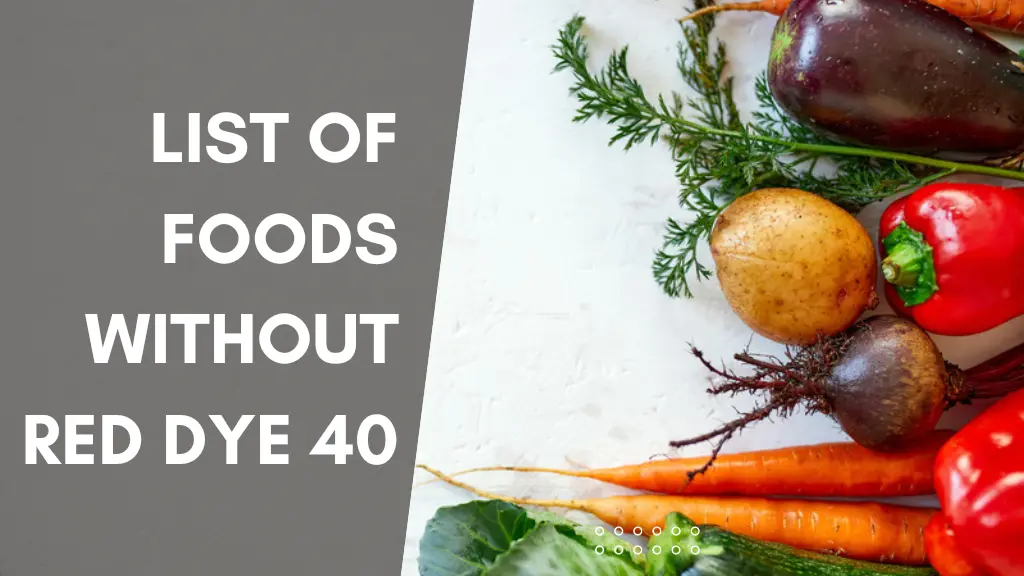Artificial food dyes have become a common part of many processed foods, snacks, and beverages. Among them, Red Dye 40, also known as Allura Red AC, is one of the most widely used synthetic colorings. While it helps manufacturers create visually appealing products, growing concerns about its potential health effects have led many people to look for safer alternatives. Some studies suggest that Red Dye 40 may trigger hyperactivity in children, allergic reactions in sensitive individuals, and could even pose long-term health risks when consumed excessively. As awareness increases, more consumers want to know about a reliable list of foods without Red Dye 40 so they can make healthier and more informed choices. This guide explores natural alternatives, popular products without synthetic dyes, and how you can navigate your diet with confidence.
Understanding Red Dye 40 and Its Concerns
Red Dye 40 is a petroleum-based synthetic dye approved by the FDA for use in many countries. It is commonly found in candies, sodas, cereals, desserts, condiments, and even some medications. The controversy around this additive stems from research linking it to behavioral issues in children and possible allergic reactions like hives or asthma. Though regulatory bodies claim it is generally safe in small amounts, parents, health-conscious individuals, and people with sensitivities prefer to avoid it altogether. This shift has increased demand for food products made with natural coloring, such as beet juice, paprika extract, or annatto, which provide rich hues without artificial chemicals.
Why Choose Foods Without Artificial Dyes
Choosing foods free from synthetic dyes is not just about avoiding potential risks but also about embracing healthier and more natural diets. Foods without Red Dye 40 often rely on whole ingredients and natural extracts for flavor and appearance. These foods usually align better with clean-label eating trends, meaning shorter ingredient lists, less processing, and greater transparency from manufacturers. Many health experts recommend minimizing synthetic additives because our bodies do not need them, and in some cases, they can create unnecessary stress on the immune system. By choosing from a trusted list of foods without Red Dye 40, families can reduce exposure to unnecessary chemicals and encourage better long-term health outcomes.
Popular Food Categories Without Red Dye 40
Beverages and Juices
Many health-conscious consumers are shifting toward beverages that rely on natural ingredients for flavor and appearance rather than artificial additives. Drinks such as cold-pressed juices, herbal teas, and flavored sparkling waters showcase the natural vibrancy of fruits without needing synthetic dyes. Instead of using chemicals for color, manufacturers highlight real ingredients like pomegranate, hibiscus, and cherry, which naturally deliver rich hues. This not only improves the nutritional profile of the beverage but also reassures consumers that they are drinking something more wholesome. Even within sports drinks and flavored waters, more brands now emphasize clean labeling, ensuring that buyers can hydrate without worrying about hidden colorings.
Snacks and Sweets
Traditional candies, gummies, and snack packs often contain synthetic dyes to create bright and attractive colors, especially for younger audiences. However, more companies are finding innovative ways to replace these dyes with plant-based alternatives. Gummy bears can now be found in versions colored with spinach extract, turmeric, or beetroot, while lollipops and hard candies often use fruit juices for natural appeal. Snack bars, trail mixes, and nut-based treats also avoid unnecessary coloring, relying instead on their authentic flavors and textures. For parents, these options are especially reassuring, allowing children to enjoy fun snacks without exposing them to questionable ingredients. The shift toward naturally colored sweets reflects a larger trend of making indulgences safer and more transparent.
Cereals and Breakfast Foods
Breakfast is a meal where artificial coloring has been used heavily, particularly in brightly colored cereals marketed to children. Thankfully, many brands have recognized the demand for cleaner options and now produce cereals that rely on fruit or vegetable-based coloring. Some cereals use freeze-dried fruits, which naturally add both color and flavor without requiring synthetic dyes. Beyond cereals, products like oatmeal cups, granola clusters, and breakfast biscuits emphasize ingredient quality rather than artificial appearance. This not only improves the nutritional value but also helps parents feel confident about their family’s morning meals. Choosing natural breakfast foods encourages better eating habits that can positively shape long-term health.
Dairy and Desserts
Yogurts, milkshakes, ice creams, and puddings often feature coloring agents to make them more visually appealing, especially in strawberry or cherry-flavored varieties. Fortunately, an increasing number of dairy brands are reformulating recipes to eliminate artificial dyes, instead using fruit purées, cocoa, or vanilla bean specks for natural appeal. Ice cream made with real strawberries provides both color and taste without additives, while yogurts often feature natural fruit layers at the bottom for authenticity. Desserts like mousse or panna cotta showcase flavors without needing artificial brightness, allowing their natural ingredients to stand out. These options demonstrate how indulgent foods can still feel fun and exciting without relying on synthetic chemicals.
Packaged and Processed Foods
It may surprise many shoppers to learn that condiments, sauces, and even savory products sometimes contain artificial dyes to make them look richer or fresher. Ketchup, salad dressings, and flavored dips are common examples where color additives appear unnecessarily. However, manufacturers are turning to natural coloring agents such as tomato paste, paprika, and red bell pepper extracts to maintain authentic appearance. This move not only eliminates unnecessary chemicals but also enhances the flavor and nutrient content of the products. Families who prefer cleaner eating appreciate these dye-free versions, as they can be incorporated into everyday meals with peace of mind. Reading labels carefully is still key, but natural options are becoming easier to find.
Baked Goods and Pastries
Cakes, cupcakes, and pastries are often decorated with bright icings and fillings, many of which have traditionally included artificial coloring. Today, bakers and brands are increasingly using natural sources such as beet juice, raspberry powder, or spirulina to achieve a variety of shades. For example, a red velvet cake can be made vibrant with natural cocoa and beet extracts rather than synthetic dyes. Donuts, cookies, and muffins sold by health-conscious bakeries also highlight real fruit-based fillings for both color and flavor. This approach not only satisfies consumer demand for transparency but also creates desserts that taste fresher and more authentic. Baked goods prove that natural ingredients can achieve beautiful results without sacrificing visual appeal.
Baby and Toddler Foods
Products designed for infants and toddlers are under increasing scrutiny, as parents seek the purest and safest options for their children. While older formulations sometimes relied on additives for enhanced appearance, many modern baby foods now emphasize natural simplicity. Pureed fruits and vegetables, toddler snacks, and small meal pouches rely on real ingredients for flavor and color. The absence of artificial dyes reassures parents that they are providing clean, wholesome nutrition during critical stages of development. Brands catering to this audience often highlight their use of organic farming and transparent ingredient sourcing. As awareness grows, dye-free baby foods are becoming standard rather than the exception, creating peace of mind for families.
Frozen Meals and Convenience Foods
The frozen food aisle often includes products with long ingredient lists, sometimes containing synthetic dyes to enhance their visual appeal after cooking. However, a growing number of frozen meals now avoid these additives, using real vegetables, herbs, and spices to achieve natural colors. Frozen pizzas, pasta dishes, and plant-based entrees are examples where companies have embraced dye-free formulations. These meals appeal to busy consumers who want quick solutions without compromising on ingredient quality. By focusing on freshness and authenticity, frozen food producers show that convenience does not have to mean artificial additives. This shift allows families to enjoy easy meals while still maintaining cleaner eating habits.
Natural Alternatives to Red Dye 40
Manufacturers increasingly turn to natural coloring agents to replace synthetic dyes. Beetroot juice provides a deep red hue, while paprika extract and annatto offer warm tones suitable for sauces, cheeses, and snacks. Fruit and vegetable concentrates not only deliver appealing colors but also add small amounts of nutrients and antioxidants. Unlike petroleum-based dyes, natural colorings align with consumer demand for transparency and healthier lifestyles. By opting for foods that use these alternatives, shoppers can gradually transition away from reliance on chemical additives.
How to Identify Foods Without Synthetic Dyes
Reading ingredient labels is the most reliable way to identify foods without artificial dyes. Red Dye 40 may appear under several names, including Allura Red AC or FD&C Red No. 40. Choosing products certified organic or labeled as “no artificial colors” ensures that they are free from synthetic dyes. Shopping at health-oriented grocery stores also increases the likelihood of finding dye-free products, as many specialty retailers prioritize natural ingredients. When in doubt, contacting manufacturers or checking their official websites can provide clarity about specific items.
Creating a Lifestyle Around Dye-Free Eating
Transitioning to foods free from artificial dyes is easier when approached gradually. Start by replacing high-consumption items like sodas, candies, or cereals with natural alternatives. Over time, your pantry and fridge can be stocked with healthier options, making it second nature to avoid additives. Parents can also educate children by involving them in grocery shopping and explaining why choosing natural foods benefits their well-being. By adopting a lifestyle centered on natural and additive-free choices, families reinforce healthier habits that last a lifetime..
Conclusion
Artificial coloring has become so common in modern diets that many people consume it daily without realizing. However, increased awareness of the potential risks associated with Red Dye 40 has encouraged consumers to explore healthier alternatives. Choosing foods that rely on natural extracts and clean-label practices ensures that meals and snacks are both nutritious and visually appealing. Whether it is beverages, snacks, cereals, or sauces, there are plenty of products available today that avoid synthetic dyes altogether. By relying on a list of foods without Red Dye 40, you can make smarter decisions, reduce exposure to unnecessary chemicals, and enjoy a diet that supports long-term health.
FAQs
Why should I avoid Red Dye 40?
Many people avoid Red Dye 40 due to concerns about hyperactivity in children, allergic reactions, and its synthetic, petroleum-based origin. While approved for use, some individuals prefer natural alternatives for better health and peace of mind.
What are some natural alternatives to Red Dye 40?
Common natural alternatives include beet juice, paprika extract, annatto, and fruit or vegetable concentrates. These provide vibrant colors without synthetic chemicals.
Are organic foods free from Red Dye 40?
Yes, certified organic foods do not contain artificial dyes, including Red Dye 40. Organic certification ensures that products avoid synthetic additives and rely on natural ingredients.
Which foods most commonly contain Red Dye 40?
Red Dye 40 is often found in sodas, candies, cereals, baked goods, sauces, yogurts, and flavored snacks. Reading labels helps identify and avoid these products.
Can Red Dye 40 affect children’s behavior?
Some studies suggest a link between Red Dye 40 and hyperactivity or attention-related issues in children, which is why many parents prefer to eliminate it from their child’s diet.





